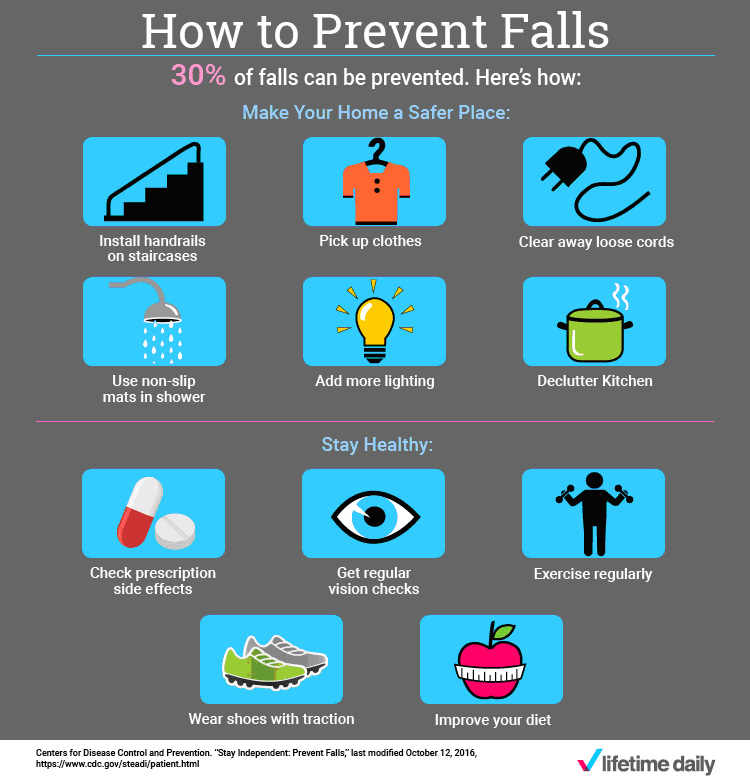Falling can change your life: How to prevent it
One minute you’re going about your business and the next — boom — you’re down. None of us plan on slipping in the bathtub or tumbling down a flight of stairs but it happens.

Falling is a big problem for adults over 65. The Centers for Disease Control (CDC) says that every year one out of four Americans aged 65 and older falls — and those are just the reported cases. But falling isn’t inevitable. With a few simple tips, including small changes to your home and work environments (plus a healthy dose of awareness), you can lower your fall risk, or that of a loved one.

A large percentage of falls can be prevented
First, determine your level of risk by completing a fall risk assessment with your doctor. Also, if you’ve fallen in the past or have a fear of falling, talk to your doctor. If you’re afraid to fall, you could take preventative measures too far and begin to limit your physical activity, which can increase your chances of falling.
Then, with the help of your doctor, begin to identify and improve your fall factors. For instance, do your medications make you feel dizzy? Do you consume alcohol? Are you physically active? Is your eye glass prescription up to date?
Denise’s fall prevention story
Denise, 68, is a tennis instructor. She recently switched to a new blood pressure medication. She’s fit, active and in generally good health, but when she got out of bed one morning and leaned over to pet her dog, she got dizzy, tripped on her slippers and fell. She wasn’t hurt, but the fall scared her enough that she checked-in with her doctor. It turns out her new medication dropped her blood pressure too low, which made her feel wobbly. Her doctor changed her dose, and now she’s doing great.
Dale’s fall prevention story
Dale, 78, is retired, lives alone and struggles with chronic pain in his legs and feet. He had one drink too many one evening and took a nosedive when he got up out of his chair. He fell on his face, got a concussion and wasn’t found by a neighbor for several hours. Dale recovered after a few days in the hospital and now he calls the accident his “wake-up fall.” He realized that if he didn’t quit drinking, the next fall could cost him his independence.
Identify your fall factors, then come up with a plan
An important part of fall prevention is creating a customized action plan that addresses each of the fall factors that you identified with the help of your doctor. For instance, if your doctor is worried you’re at an increased risk for falling, they may:
- Recommend you have your vision checked
- Prescribe different or fewer prescription medications
- Schedule an occupational therapist to conduct a home safety assessment
- Prescribe an exercise plan to help strengthen your muscles
- Suggest you meet with a nutritionist to make sure you’re getting the nutrients you need
- Discuss how drinking or recreational drug use affects balance and reflexes
Fall prevention tips
To improve the odds of staying on your feet, consider adopting these healthy habits:
1. Join a fitness class or start exercising at home.
The exercises do not need to be strenuous, even a little can go a long way. “One of the best ways to reduce your risk of falling, and your fear of falling, is to do an exercise regime like Tai Chi for one hour, three days per week,” says Elizabeth Eckstrom, MD, associate professor and director of geriatrics at Oregon Health & Science University in Portland, OR. A study found that older adults who participated in a Tai Chi program, three days a week over a 6-month period experienced improved balance and physical performance. Not only did study participants experience fewer falls, they also reported they were less afraid of falling.
2. Drink plenty of water.
Dehydration is a serious issue, especially for people who are older. Researchers estimate that between 20-30% of older people have water-loss dehydration. Also, avoid alcohol and other substances that could affect your balance, vision, reflexes and strength.
3. Review your prescriptions regularly.
Talk to your pharmacist and your physician about which drugs are critical, and which ones you may no longer need. Also, ask your pharmacist to review your prescription each time you refill.
4. Download a pill reminder app.
Forgetting to take prescription medications is common. Try an app like the Medisafe Pill Reminder and Tracker, available on Apple iOS or Android, to manage pill usage. Push notifications, text messages and email reminders are a great way to help stay on top of your prescription medication requirements. (Especially, if you’re forgetful.)
5. See your eye doctor.
An updated prescription and new pair of specs is a fall prevention technique that’s well within your control.
6. Wear sensible shoes.
Consider shoes with plenty of support, traction and stability. There are lots of fashionable options out there that meet these criteria.
7. Make improvements at home
Start by getting rid of throw rugs, dangling cords and wires and other clutter in the areas where you walk (or consider using non-skid mats under rugs you want to keep). Also, always use a non-slip mat in the shower.
Additional lighting in high-traffic areas such as stairways, bedrooms, hallways and bathrooms is also helpful (i.e., brighter bulbs, night lights). Also, consider putting handrails on both sides of stairways. And finally, always carry a cell phone or an emergency device to alert someone in case of a fall.
Supporting these points is Joseph Brence, a physical therapist, educator and researcher from Pittsburgh, PA. “Many people fall because they experience changes in their vision and strength,“ says Brence. “Physical therapists often recommend simple changes such as keeping your pathways lit and performing daily exercise, which have been shown to decrease incidences of falls.”
Author
Jeanne Faulkner, RN Originally published at Lifetime Daily
Editor’s note: This is part 3 of Lifetime Daily's three-part series on the risks of falling and how to reduce injuries from a fall. To view part 1 "The importance of telling your doctor about a fall" click here. To view part 2 "Afraid to fall? You're not alone"click here
Note: This information is not intended to replace a one-on-one relationship with a qualified healthcare professional and is not intended as medical advice. It is intended as a sharing of knowledge and information from research. The view expressed here are not necessarily those of the ICAA, we encourage you to make your own health and business decisions based upon your research and in partnership with a qualified professional.
Share































